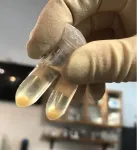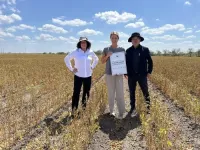(Press-News.org)
(Jackson, Wyoming – Embargoed until Thursday 12 September 2024 8:00 PM EDT)
A highly accurate diagnostic blood test has been developed for amyotrophic lateral sclerosis (ALS), a progressive neurodegenerative disease that effects neurons in the brain and spinal cord.
ALS leads to gradual paralysis, ultimately resulting in the inability to walk, speak, or, in later stages, move. Currently, diagnosis is based on a thorough clinical examination, but it can take up to 12 months to provide a definitive diagnosis, by which time many patients have significantly deteriorated. Misdiagnosis rates vary widely, occurring in as many as 68 percent of cases, further complicating timely and accurate treatment.
Researchers from the not-for-profit Brain Chemistry Labs in Jackson Hole, Wyoming, published the study today in the journal Brain Communications produced by Oxford University Press.
The diagnostic test requires only a simple blood draw and is based on small sequences of nucleic acids, known as microRNA, extracted from tiny vesicles released by the brain and nervous system.
Analysis of microRNA sequences from hundreds of patient samples allowed researchers to develop a unique “ALS fingerprint” comprising eight distinct microRNA sequences. These sequences can sensitively and specifically distinguish blood samples of ALS patients from healthy controls and from patients with conditions that mimic ALS in its early stages, with an overall accuracy of up to 98%.
Scientists hope the test will become a tool to help neurologists make more rapid diagnoses.
“Rapid diagnosis will allow treatment to begin earlier leading to better outcomes for ALS patients,” remarked Brain Chemistry Labs scientist Dr. Sandra Banack, senior author on the paper.
This new test follows on the heels of three prior validation studies using different patient cohorts for a total sample size of 471, with many of the samples provided by the USA National ALS Biorepository.
Dr. Paul Alan Cox, Executive Director of the Brain Chemistry Labs, hopes to make this test widely available within 18 to 24 months to neurologists by securing a diagnostic company partnership.
Brain Chemistry Labs is a 501(c)(3) not-for-profit organization in Jackson, Wyoming that seeks to discover new ways to prevent, diagnose and treat ALS, Alzheimer’s, Parkinson’s and other serious brain diseases. Learn more at www.brainchemistrylabs.org.
The Brain Communications paper, “A microRNA diagnostic biomarker for amyotrophic lateral sclerosis” (DOI 10.1093/braincomms/fcae268) after embargo can be accessed at https://academic.oup.com/braincomms/article-lookup/doi/10.1093/braincomms/fcae268
END
Without immediate action, humanity will potentially face further escalation in resistance in fungal disease, a renowned group of scientists from the across the world has warned. The commentary - published in The Lancet this week - was coordinated by scientists at The University of Manchester, the Westerdijk Institute and the University of Amsterdam. According to the scientists most fungal pathogens identified by the World Health Organisation - accounting for around 3.8 million deaths a year - are either already resistant or rapidly acquiring resistance to antifungal drugs.
The authors argue that the currently narrow focus on bacteria will not fully combat antimicrobial resistance ...
Review in The Lancet finds that one in five globally are at risk of contracting cardiovascular diseases, because they carry a genetic risk of high levels of a specific lipoprotein, which can be tested for and possibly treated.
20 % of the world population carries a genetic risk factor for cardiovascular diseases such as heart attacks, strokes, and aortic valve stenosis: Increased levels of a lipid particle called lipoprotein(a). It is the most common genetic cause of cardiovascular diseases.
“Lipoprotein(a) is the direct cause of cardiovascular diseases much like cigarettes cause ...
Huge gamma-ray burst collection 'rivals 250-year-old Messier catalogue'
Royal Astronomical Society press release
RAS PR 24/24
Embargoed until 00:01 BST on Friday 13 September 2024
Hundreds of gamma-ray bursts (GRBs) have been recorded as part of an enormous global effort so extensive it "rivals the catalogue of deep-sky objects created by Messier 250 years ago", astronomers say.
GRBs are the most violent explosions in the Universe, releasing more energy than the Sun would in 10 billion years. They occur when either a massive star dies or two neutron stars merge.
The explosions are so ...
Sea otters are famed for their luscious pelts, but the fur almost led to their extinction. By 1938, only a tiny population of ~50 remained clinging to the central California coast. Since then, the mammals have battled back; however, the charismatic creatures are still at risk from crude oil spilled by offshore rigs. But no one knew how severely crude oil impacts the buoyancy of sea otter fur or how well it recovers after cleaning. And Kate Riordan from California Polytechnic State University San Luis ...
Semaglutide and tirzepatide treatment lead to significant weight loss and improve blood sugar control in individuals with type 1 diabetes (T1D) who are living with overweight or obesity, new research being presented at the annual meeting of the European Association for the Study of Diabetes (EASD) in Madrid, Spain (9-13 September) has found.
The two relatively new drugs are approved to treat type 2 diabetes and for weight loss. In type 2 diabetes, they help the body produce more insulin when needed. ...
Despite high use of continuous glucose monitoring and insulin pump therapy, fear of hypoglycaemia (low blood sugar) remains a significant barrier to physical activity and exercise for adults with type 1 diabetes (T1D), according to new research to be presented at this year’s Annual Meeting of The European Association for the Study of Diabetes (EASD), Madrid (9-13 Sept).
However, the findings suggest that if exercise and diabetes management are discussed in the clinic, this fear could be reduced.
“Regular exercise can help individuals with diabetes to achieve their blood glucose goals, improve their ...
A series of case reports to be presented at this year’s Annual Meeting of The European Association for the Study of Diabetes (EASD), Madrid (9-13 Sept), describe how a technology giving insulin doses informed by an insulin pump algorithm helped three adults with type 1 diabetes better manage their blood sugars enabling them to lead more active lives, and even run marathons.
The AID system contains an advanced hybrid closed loop algorithm that automates the delivery of both basal and correction bolus insulin every 5 minutes based on sensor glucose values.
“It is great to see advances in ...
By John Lovett
Arkansas Agricultural Experiment Station
FAYETTEVILLE, Ark. — Muscadines may be the folksy American of the grape world, but they have many qualities like disease resistance and unique flavors that are desired in the more popular Vitis vinifera (bunch grapes) species.
Likewise, Vitis vinifera — the species that most people eat as table grapes and drink in wine — has many characteristics desirable for muscadines, like thinner skin, a crispier texture and seedlessness. Successfully combining traits from these two species of grapes is a challenge due to differing numbers ...
Workplace communications platforms such as Slack and Microsoft Teams are sometimes accused of reducing productivity by distracting workers with constant messages and the need to respond to them.
But new research by Wen Wen, associate professor of information, risk, and operations management (IROM) at Texas McCombs, shows that companies can use them to do the opposite: to motivate workers.
How? By praising successful employees in all-staff channels that everyone can see — especially when they can’t see one another face-to-face.
“One important challenge faced by many companies is how to motivate remote workers and keep them productive,” ...
UT Arlington biologists, working with underserved farmers in South Texas, have harvested their first crop of climate-smart soybeans. This harvest is part of a four-and-a-half-year, $5 million project funded by the U.S. Department of Agriculture (USDA) to test whether climate-smart agricultural practices can reduce emissions of greenhouse gases (GHGs) responsible for climate change—including carbon dioxide, methane, and nitrous oxide—while simultaneously increasing crop production.
“We ...




